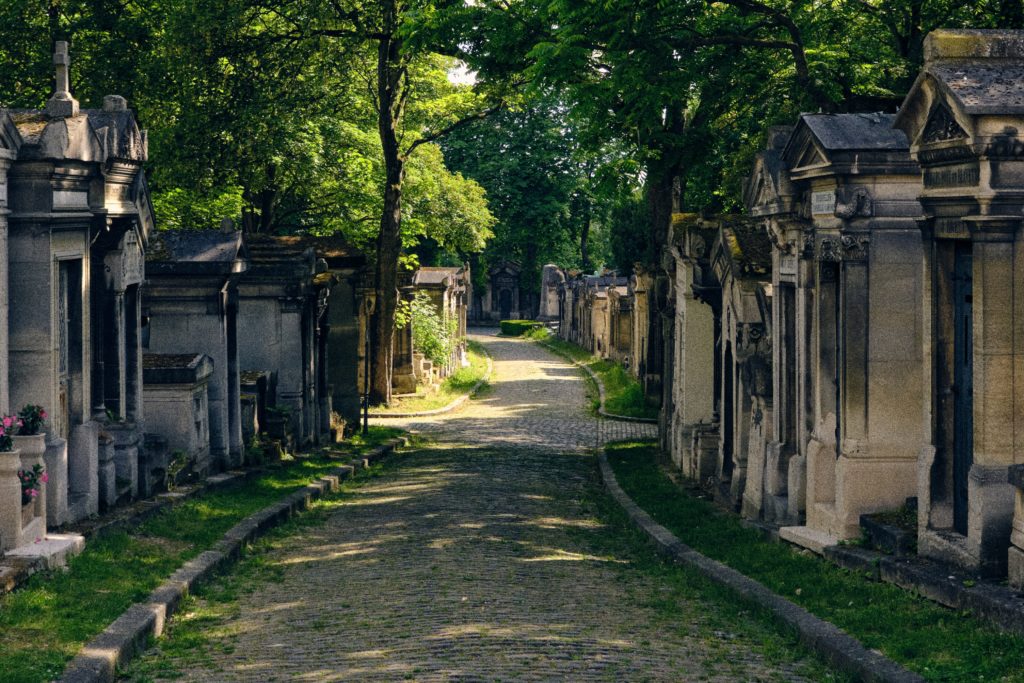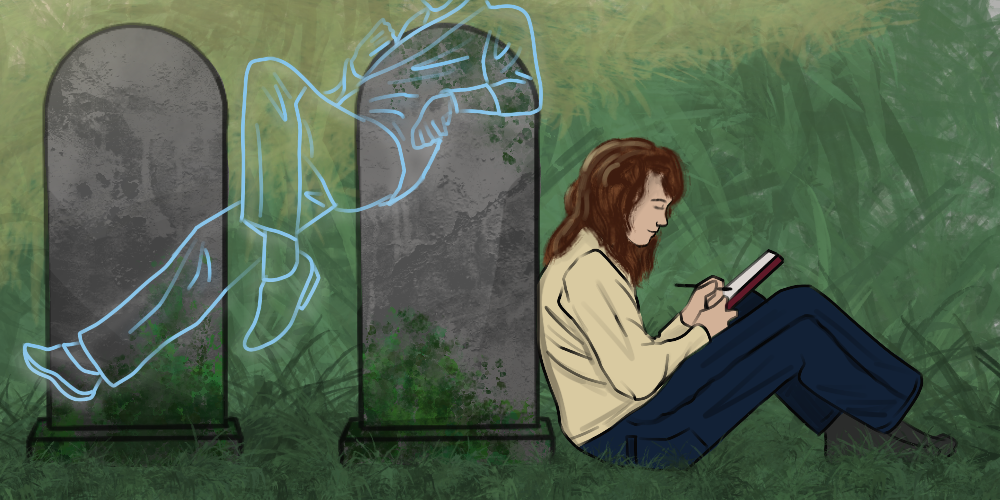I have always been enticed by graves. Or more specifically, graves or tombs of well-known figures. I suppose I’ve forever been entranced by the untouchability of the rich and famous, therefore one must wait until their decease to be within reach of their supposed greatness. There’s also something magical about being in the presence of genius; a figure who lived long before your existence, considered and adored by all to the extent they become somewhat of a myth, like Oscar Wilde. Another part of me believes that I’ll absorb any remanence of creativity that lies within the soil of these icons’ final resting places. Though, when the romanticism of this idea wears off, essentially — for us normal folk — it’s the closest we could physically get to a celebrity.
Prior to my move to Paris, the closest I came to visiting a significant grave was that of Karl Marx in Highgate Cemetery. However, this sighting came at a cost of four pounds, and my teenage bank balance could not take that hit. During the first lockdown, when the hours were endless and boredom became the new norm, I decided to channel my creativity into short stories, taking inspiration from a small graveyard near my family home in South Cambridgeshire. As I began frequenting the burial ground — with my dog during our daily walks I must add — I became increasingly familiar with certain graves and started conjuring up back stories for deceased members of the village. I was particularly interested in the tombstone of William Peacock, who lived between 1838 and 1896. What intrigued me about Peacock’s grave was the quote written just beneath the year of his decease, it read “Thy will be done.” Though in hindsight this may have been a biblical reference, I preferred to believe that Peacock was a bitter older gentleman who believed revenge would come to those that had wronged him. I decided, based on the years he had lived, that Peacock was a chartist and thus became bitter and hostile when the movement lost momentum. I believed that he then moved to the small village of Caxton as the uppity college-goers and visible wealth in Cambridge’s city center were too infuriating for poor William.
In comparison to these humble village graves, the deaths of beloved French citizens seem to be an opportunity to demonstrate some creativity. The three main cemeteries are in different corners of the city — Père Lachaise in the east, Montmartre in the north, and Montparnasse in the south. Though each necropolis is similar in style, Lachaise is where you want to head. If I were a tour guide or salesman for the site, here is how I’d lure you: ‘with maps at your disposal, you can guide your way through the labyrinth of elaborate tombs in search of your favorite artist, or alternatively, saunter down the unfailingly perfectly lit cobbled paths and stumble across a beautifully celebrated life of a deceased Parisian resting amongst those equally grandiose.’ At first glance, these cemeteries are gothic and haunting, with many tombs resembling Greystone chapels and many a black cat appearing out of the cracks and ill-fatedly crossing your path. Despite the cliched horror-movie setting, the experience is nothing but peaceful. It is for this reason that I found the varying sites the perfect setting for solace when I was feeling hungover and sorry for myself.
When nobody was looking, I’d reach out and place a hand on the aging stone that concealed the likes of Serge Gainsbourg or Marcel Proust, convincing myself that I could feel their artistic juices entering my body and igniting a visionary thought. For those few seconds, I was rid of my lingering hangover and believed that I could probably conquer the art world too. I was always engrossed by Gainsbourg’s grave, possibly because he died just a few decades ago, and I held the belief that there’d still be a glimpse of his menacing desirability yet to decompose if the tomb head were to be lifted. Though his tomb is small, it is often scattered with cigarette buts and used metro tickets — in tribute to “Le Poinçonneur des Lilas” (“The Ticket Puncher of Lilas”) — making his presence very much felt. I once, in a hungover haze and with a Serge-induced creative itch, sat on a bench opposite him and took out my notebook in an attempt to write something resembling a poem. The words I jotted down had little cohesion, however, it soon came to my attention that I was being noticed by those also visiting the singer’s grave. Seemingly, onlookers thought I was writing something of worth as one nosey parker not-so-casually walked behind my bench to take a peek at what I was up to. Sadly, the ghost of Serge Gainsbourg was not guiding my pen and my sad little thoughts never saw the light of day.
Alongside the mausoleums, an assortment of characters can be found lingering around the sites. On my first trip to Père Lachaise with my mum, a few years prior to my move, a scraggly and whimsical gentleman got a whiff of our quest to find Oscar Wilde’s grave and insisted on us following him as he knew its exact location. So, like the naïve English ladies we are, we agreeably followed. Our unauthorized tour guide weaved us through the entire site, his shaggy hair and excitable limbs struggling to keep up with us. He insisted if we just went round this corner and through that path, we’d quickly be at the writer’s tomb. As we journeyed through the sea of grey, the misfit would sporadically throw facts at us as he loosely flung his arm to point in various directions. As we approached the very spot where we’d first been acquainted, we dismissed our new friend and told him we’d like to find the grave ourselves. Before we could escape, the man held out his hand and asked for compensation for the voyage that neither my mother nor myself had asked for. We shook our heads and reminded him that he hadn’t taken us to the one spot we’d requested. As he realized that we weren’t to be taken as fools, he speedily leached onto another group of lost English tourists and set off on his next excursion.
During my time spent in Paris, I had various friends and family members venture out of British soil to come and visit me. If you have a visa, you will never be short of things to do in the city, as you’re granted free access to all museums and galleries. However, with a visiting Brit, things can get expensive quickly, that’s why I’d often suggest a trip to any of the three cemeteries. Once, when in Montparnasse with my boyfriend, we came across a noteworthy individual when on the hunt for Charles Baudelaire’s grave. I was aware that the poet’s resting place was rather demure in comparison to Wilde’s grandiose sphinx, however, we managed to stumble across Baudelaire with great ease due to the mysterious figure perched beside it. A man sat facing the decomposing flowers that lay upon the modest tomb, accompanied solely by Baudelaire’s spirit and a book of his poems — to which he appeared to be engrossed in. Though it was a peaceful sight to observe, I left feeling disgruntled at my poor understanding of French, meaning I’d never be able to read these poems in their truest form. Around this period, across the English Channel, my dad had picked up a book of Baudelaire poems himself. He’d become something of a fanboy and rarely failed to mention the poet during our fortnightly phone calls. The book was, of course, translated into English, and according to my dad, one of the inspiring aspects of the poems was their clever rhymes. This took me by surprise, as these rhymes had obviously not come from Baudelaire, but from a translator attempting to keep the original meaning present through his own creativity. What a shame the translator’s name has been misplaced as he clearly earned such an ardent fan in my dad.

It’s a known fact that Paris rains. And on days when I struggled to find romance in the daily showers, but still wanted to be up close and personal with Paris’s former residents, I’d head to the Pantheon or Invalides’ crypts. Although the tombs of Oscar Wilde, per se, were remarkable, despite now being encased in a glass shield covered by decaying lipstick marks, I always enjoyed stumbling across seemingly modest graves, only to find out they were a renowned sculptor or composer. Once in the Pantheon, I was undergoing my tourist duties and searching for the resting spot of Victor Hugo, when I stumbled upon the creator of the tactile writing system — Louis Braille. I was roused by this siting since when priorly researching the Pantheon’s list of tombs, this name did not make the top five. Despite my excitement at this discovery, I must not fail to mention the most stirring tomb of them all: Napoleon’s. When I first moved to Paris, I was most excited by the prospect of visiting the graves of people I was an active fan of, such as Serge Gainsbourg. Napoleon to me was like a folk hero, feverishly mentioned in pop culture and often name-dropped when describing the characteristics of an angry short man. I had been reluctant to visit Hotel des Invalides, where the tomb is housed, as you enter through the Army Museum entrance, an area lined with many military canons which always successfully intimidated me. After hearing that my friend, Olivia, had an interest in war history, I made her accompany me to the Army Museum and consequently, to visit Napoleon.
When you enter Hotel des Invalides, you feel as though you are in the presence of royalty as you stand beneath a regal gold dome roof that looms over you, encrusted with all its intricate gold leaf glory. As I absorbed the setting, it was clear that Napoleon was here. After flashing your ticket to security, your eyes are quickly drawn to a skeleton hanging from the very top of the dome by what looks like a 50-meter piece of dental floss. Olivia and I closely examined the bones, quickly confirming that it was not in fact dinosaur remains. It was, though, Napoleon’s horse. As we approached the animal, we realized it was dangling above Napoleon’s tomb itself. It was a striking sight, sanctimonious enough that it felt as though it may have been a request by the former French emperor himself. In order to get a closer look at the tomb, you descend down a spiral staircase where you’re met by two grandiose stone figures who guard the crypt. Encircling the grave are twelve stone guardian angels, all intensely glaring at the central chest and making the scene feel eerily reminiscent of the famed weeping angels of Doctor Who. Sadly, I couldn’t place my hand on the crypt as the public cannot get closer than approximately fifteen feet, thus no revolutionary guidance was absorbed that day.
As I recently journeyed back to the U.K., I felt inclined to write about these almost celebrity encounters, mainly because the experience is so vastly different from meandering around an English burial ground. If you search the graves of, for instance, Sylvia Plath or John Lennon — both of whom are buried in England — like most of our country’s residents, what you’ll find are grey cracked slabs of concrete, all unworthy of photography as the engraved names are barely visible. England needs to step up its game and start celebrating the deceased as feverishly as we do when they are living. I want to be able to place my hand on the likes of Emily Bronte and George Harrison and encompass some of their creative juices. And most importantly, I don’t want to pay to visit Karl Marx.•




